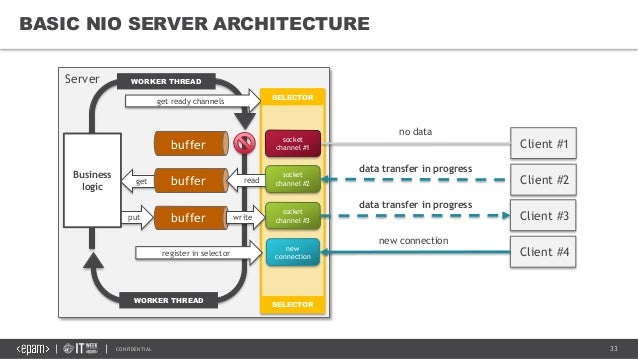Netty Cookbook - free ebook for Java Developer

Introduction
Netty.io is a popular open source library that greatly simplifies the development of network applications on top of the JVM. It abstracts the burden to deal with tedious low level details and allows you to concentrate on your business logic instead. It is used by high profile companies like Red Hat, Twitter or Facebook and designed from the ground up to handle high throughput at low latency, even with thousands of connections at the same time.
In this book, you are going to build both client and server using netty best practices, which are communicating with each other in a completely asynchronous fashion. We are going to explore the netty pipeline, how you can reuse existing protocol handlers and how to write your own.

In this book, you are going to build both client and server using netty best practices, which are communicating with each other in a completely asynchronous fashion. We are going to explore the netty pipeline, how you can reuse existing protocol handlers and how to write your own.

Table of Contents
Chapter 1: Communicating in Asynchronous World with Netty (15 pages)
Introduction
Recipe 1.1 Building an asynchronous TCP server and client
Recipe 1.2 Sending hello message to server when connection is ready
Recipe 1.3 Receiving message asynchronously
Recipe 1.4 Get notification from Netty I/O operations
Recipe 1.5 Get notification from ChannelHandler states
Recipe 1.6 Data pipeline processing with ChannelHandler
Link https://docs.google.com/document/d/1LFESj97DKCftwI1y3d8yZ9lPIhWdoeo15IRvtrabbI4/edit?usp=sharing
Link https://docs.google.com/document/d/1LFESj97DKCftwI1y3d8yZ9lPIhWdoeo15IRvtrabbI4/edit?usp=sharing
Chapter 2: Solving common network programming problems (30 pages)
Recipe 2.1 Getting the local SocketAddress and the remote SocketAddress
Recipe 2.2 Sending and receiving data in Stream-based TCP/IP Transport
Recipe 2.3 Sending data in POJO way with Custom Codec
Recipe 2.4 Listening multiple sockets in one Netty instance
Recipe 2.5 Counting Server Bandwidth in ChannelHandler
Recipe 2.6 Checking Heartbeat Server using UDP
Recipe 2.7 Using Stream Control Transmission Protocol (SCTP) codec
Recipe 2.8 Building simple FTP server
Recipe 2.9 Building server RPC (Remote Procedure Call) with Apache Avro
Recipe 2.10 Building HTTP file downloader
Link: https://docs.google.com/document/d/1VhBTcJVkhhmrPZXH6r0xOztmqVZkGKC4vx6sxK5hR1M/edit?usp=sharing
Link: https://docs.google.com/document/d/1VhBTcJVkhhmrPZXH6r0xOztmqVZkGKC4vx6sxK5hR1M/edit?usp=sharing
Chapter 3: Netty for the Web (20 pages)
Introduction
Recipe 3.1 Routing HTTP request to business logic
Recipe 3.2 Integrating Netty with Spring MVC
Recipe 3.3 Serving static content
Recipe 3.4 Cross-Domain Ajax Requests with CorsHandler
Recipe 3.5 Enabling SPDY protocol for faster web
Recipe 3.6 Your Server as a Function
Link: https://docs.google.com/document/d/1nIdK_vtHu0FMl-vAzGsCOYQSKh4_Vj5_yB4aoE1Rov8/edit?usp=sharing
Link: https://docs.google.com/document/d/1nIdK_vtHu0FMl-vAzGsCOYQSKh4_Vj5_yB4aoE1Rov8/edit?usp=sharing
Chapter 4: Going Real Time Web (10 pages)
Introduction about real-time web
Recipe 4.1 Using WebSocket for streaming messages from Twitter
Recipe 4.2 Simple chat application with Netty STOMP Codec
Recipe 4.3 Displaying online users with Redis and netty-socketio
Recipe 4.4 RxNetty for filtering and pushing data in real-time
Chapter 5: Asynchronous networking on mobile (10 pages)
Introduction
Recipe 5.1 Implementing lightweight network protocol for mobile app
Recipe 5.2 Using Netty on Android OS
Recipe 5.3 Asynchronous HTTP Client for Android app
Recipe 5.4 Implementing location-based app with netty-socketio and Lucene Spatial
Chapter 6: Implementing Security, Encryption, and Authentication (10 pages)
Introduction
Recipe 6.1 Implementing HTTP Authentication Client and Server
Recipe 6.2 Implementing IP Filtering to protect your server
Recipe 6.3 Using SelfSignedCertificate to secure networking
Recipe 6.4 Managing distributed session with Memcached Binary protocol
Recipe 6.5 Setting up an HTTPS web server
Chapter 7: High performance Web with HTTP/2 (10 pages)
Introduction about HTTP/2
Recipe 7.1 Using codec-http2 to improve the speed of Web
Recipe 7.2 Enabling multiple streams in single connection
Recipe 7.3 Setting priority in requests
Recipe 7.4 Compressing data response
Recipe 7.5 Enabling server push
Recipe 7.6 Building better static file server for high concurrency
Chapter 8: Connecting Netty to Big Data Ecosystem (15 pages)
Introduction
Recipe 8.1 Building scalable log aggregation server with Netty and Apache Kafka
Recipe 8.2 Distributed HTTP event processing with Akka Actor
Recipe 8.3 Stream Data Processing with Netty and Java 8 Stream API
Recipe 8.4 Monitoring Social Data with Netty HTTP Client and Redis Queue
Recipe 8.5 Making real-time dashboard with Websocket and nvd3.js



Comments